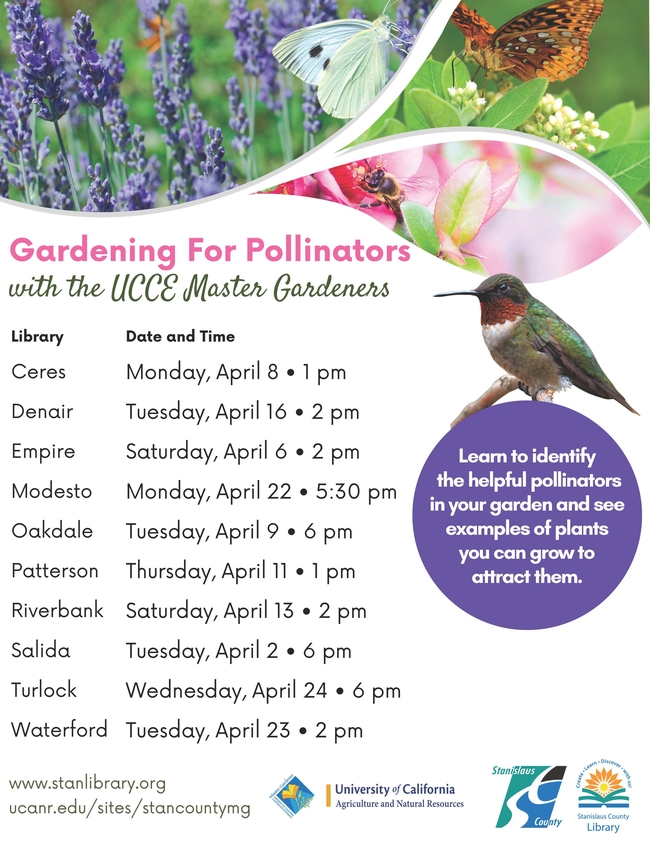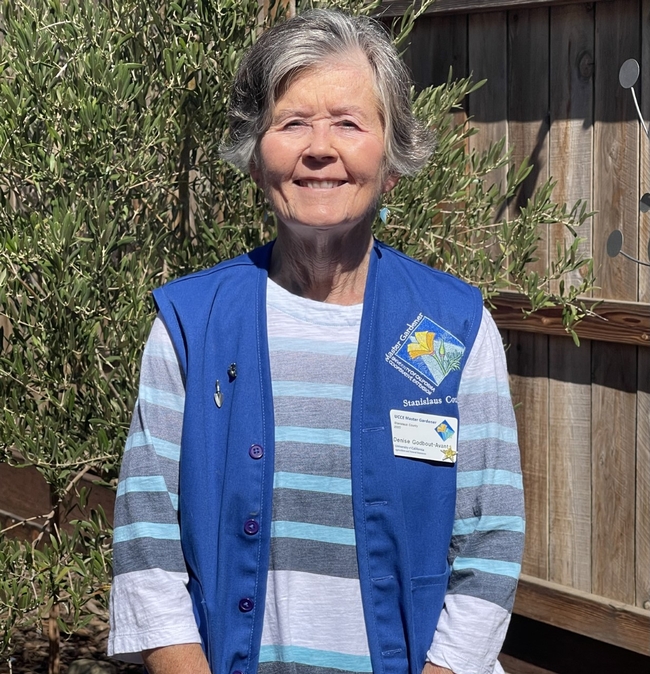- Author: Denise Godbout-Avant
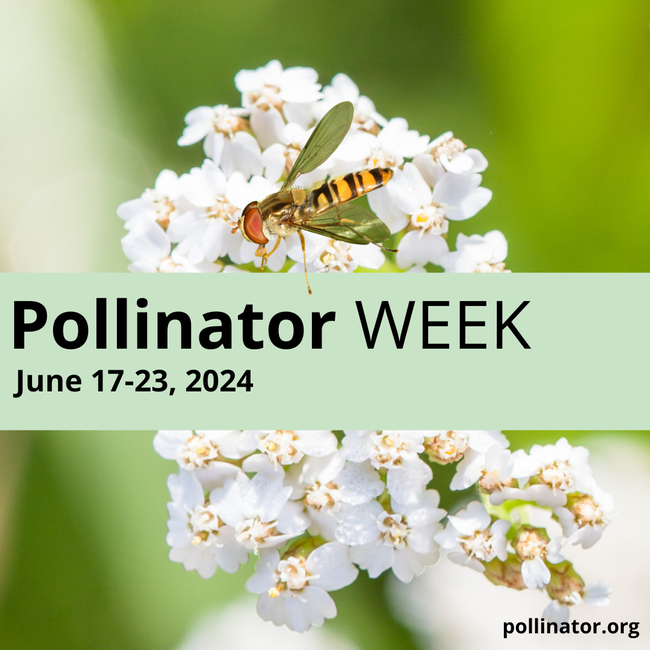
Pollinators receive food in the form of nectar (source of sugar) or pollen (source of protein, fat, and other nutrients). In the process of moving from flower to flower to feed, pollinators disperse pollen grains among plants of the same species, enabling the plants to reproduce. Flowers have evolved over long periods of time into many colors, shapes and scents to attract their pollinators, thus creating a mutually beneficial relationship.
The Pollinators
While bees are the primary pollinators, other insects including butterflies, moths, flies, beetles, wasps, some birds such as hummingbirds, and bats also play important roles.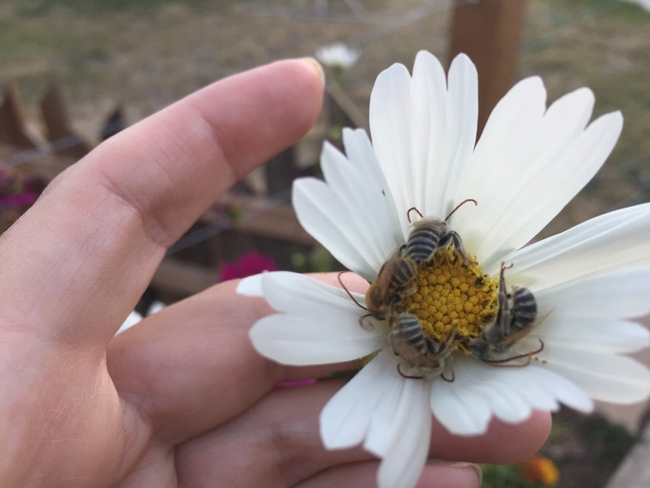
Honeybees & Native Bees
Honeybees (genus Apis) are the bees we are most familiar with. However, honeybees are just one species of a very diverse group with over 20,000 species worldwide, 4,000 species in the USA and 1,600 in California. Native bees come in a variety of shapes, colors, sizes and lifestyles that make them very efficient pollinators. Unlike honeybees and bumblebees, which are social bees living in colonies, native bees are solitary with 70 percent nesting in the ground with the rest nesting in wood and plant stems.
Butterflies
Butterflies are daytime flying insects who often have gorgeous colorful wings. Their larvae sometimes require a specific plant to feed on, though most adults will get their nectar from many plants.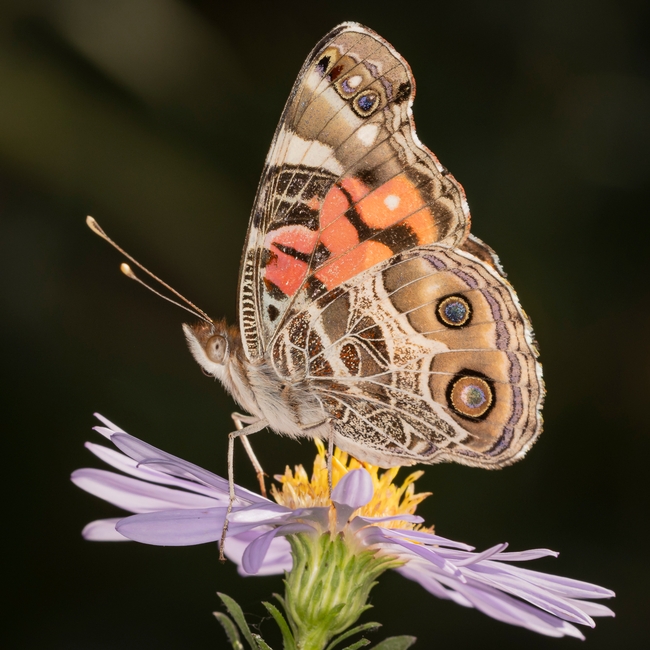
Moths
Moths are mostly evening and nighttime fliers, though some are out in the late afternoon or early morning. They are attracted to sweet-smelling flowers. Less colorful than butterflies, they are easily differentiated from butterflies by their “feathery” antennae.
Flies
Flies are not generally thought of as pollinators, however many are, particularly hover flies (family Syrphidae) and bee flies (family Bombyliidae), both of which are generalist pollinators. Generalist pollinators visit a wide range of plants, making them important inhabitants of gardens and fields.
Beetles
Beetles are a large group, with up to 28,000 species in the USA. Most beetles are not pollinators, but some do visit flowers for nectar or pollen and help fertilize some flowering plants, particularly magnolias.
Wasps
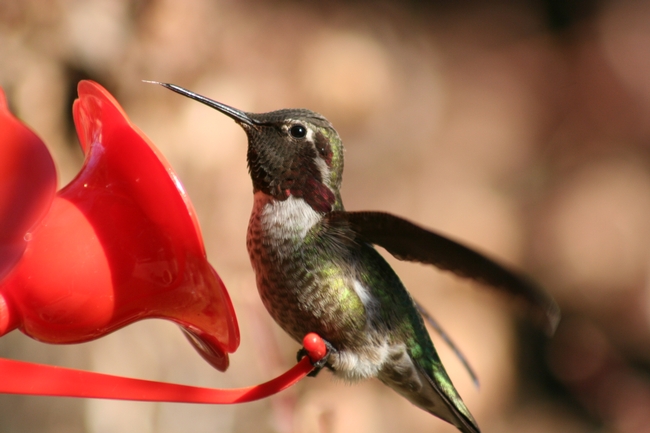
Hummingbirds
Hummingbirds are the most prominent pollinating birds in the Americas. With their long beaks, they can reach deep into flowers while sipping nectar. In addition to nectar, they also forage on insects and spiders.
Bats
Bats are nocturnal pollinators that play an important role in pollinating cacti and agave, as well as many tropical and subtropical plants including bananas, avocados, century plants and cashews. Species such as Mexican long-nose bat (Leptonycteris nivalis) have evolved heads and long tongues to access light-colored flowers which open at night, often producing abundant nectar and pollen.
How You Can Help Pollinators

Pollinators need a diversity of flowers with lots of nectar and pollen. They require easy access to flowers blooming throughout the seasons, particularly during late winter, early spring, and late autumn seasons when fewer flowers bloom. Different flower species provide differing amounts of nectar. Native plants generally provide more nutritious nectar for pollinators, so they attract more pollinators. Download the Xerces Society Recommended Plants for the Central Valley Region for a list of plants.
To help protect pollinators, if you choose to use a pesticide, select one that are less toxic, such as an insecticidal soap or oil. Avoid broad-spectrum sprays that kill numerous insects. Spray on non-windy days in the early morning or late evening when pollinators are not present. Use UC Integrated Pest Management for information on pests and pest management (https://ipm.ucanr.edu/).
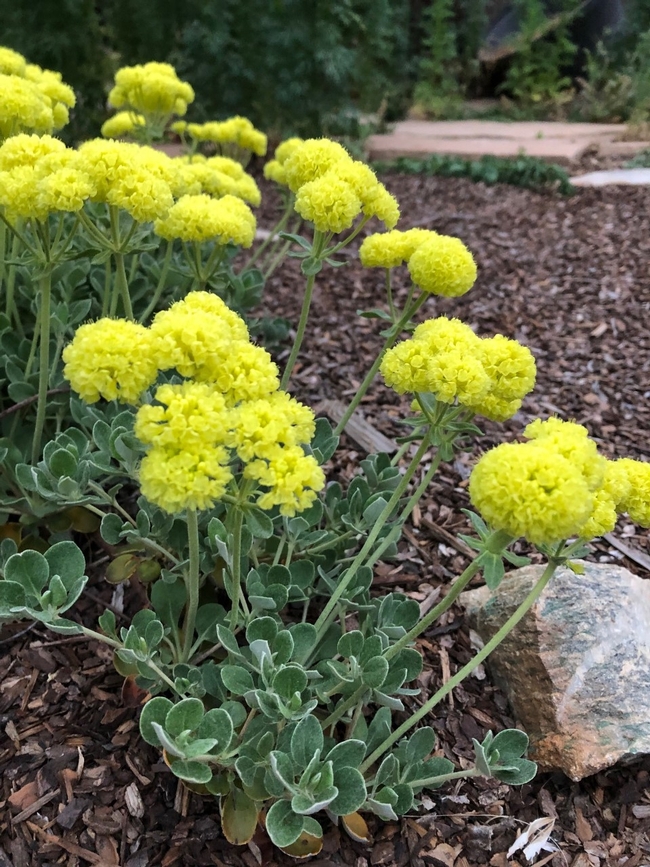
Citations
- The Pollinator Partnership https://www.pollinator.org/
- Xerces Society book: Attracting Native Pollinators: https://xerces.org/publications/books/attracting-native-pollinators
- California Native Plant Society (CNPS) native planting guides: https://www.cnps.org/gardening/choosing-your-plants/native-planting-guides
Free Resources from University of California and your local UC Master Gardeners
- CA Friendly Friendly Garden Recipes https://anrcatalog.ucanr.edu/Details.aspx?itemNo=8518
- How to Attract and Maintain Pollinators in your Garden https://anrcatalog.ucanr.edu/Details.aspx?itemNo=8498
- UC Stanislaus County Master Gardener: Butterflies in Your Garden with list of plants that attract butterflies: https://ucanr.edu/sites/CEStanislausCo/files/345791.pdf
- Gardening for Pollinators and Diversity from UC Davis Arboretum: https://arboretum.ucdavis.edu/pollinator-gardening
- Bees in the Neighborhood: best practices for urban gardeners. https://anrcatalog.ucanr.edu/Details.aspx?itemNo=8596
Books and ID Cards for Purchase
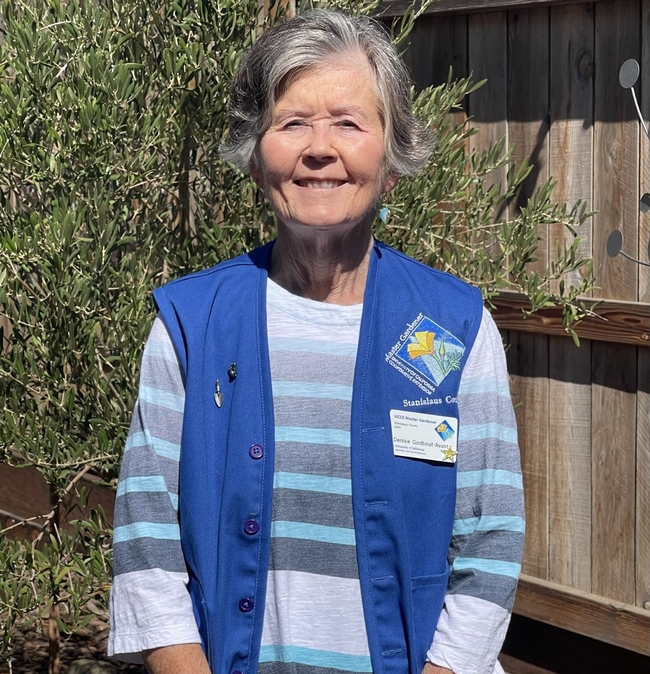
Common Plants to Attract California Native Bees https://anrcatalog.ucanr.edu/Details.aspx?itemNo=3557
Want both cards? Bundle and save $10 at https://anrcatalog.ucanr.edu/Details.aspx?itemNo=3557BUN
Denise Godbout-Avant has been a UC Cooperative Extension Master Garden in Stanislaus County since 2020.
- Author: Denise Godbout-Avant

Bees are pollinators. Pollinators are crucial to the success of flowering plants by transporting pollen, thus allowing fertilization to occur. We would not have fruits and vegetables on our kitchen tables without them. They are vital to California's agriculture industry.
California's wide diversity of habitats supports a corresponding diversity of pollinators. Bees are the main pollinators with butterflies, other insects, and some birds such as hummingbirds also playing important roles. California has an estimated 1,200 – 1,500 native bees and over 200 species of butterflies.
What do Pollinators Require?
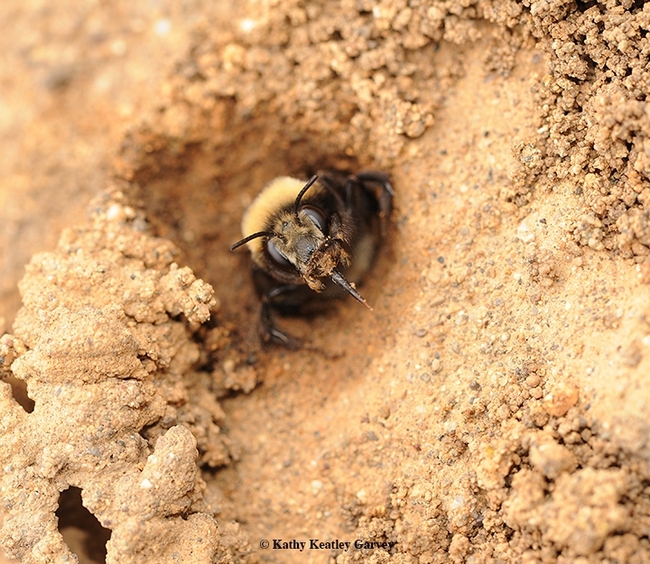
Due to climate change, the reduction of native habitats, and environmental chemicals, many pollinators are struggling. Providing plants in our gardens that attract pollinators can produce lovely, colorful landscapes while also benefiting pollinators.
Visit La Loma Native Plant Garden's Festival
You can see native plants that attract pollinators by visiting La Loma's Native plant garden on 1805 Encina Avenue in Modesto anytime. Or attend the Pollinator Festival, a free event held by the North San Joaquin Chapter of the California Native Plant Society on Saturday, April 13th 2024 from 10am – 2pm. Stop by the UC Cooperative Extension Master Gardener booth to see our insect collection and get a free packet of flower seeds.
The event will have a pollinator parade at 10:15, as well as face painting, music, food, and more! You can also hear from an entomologist on the importance of pollinators.
Learn More In-Depth Information About Pollinators at Library Talks
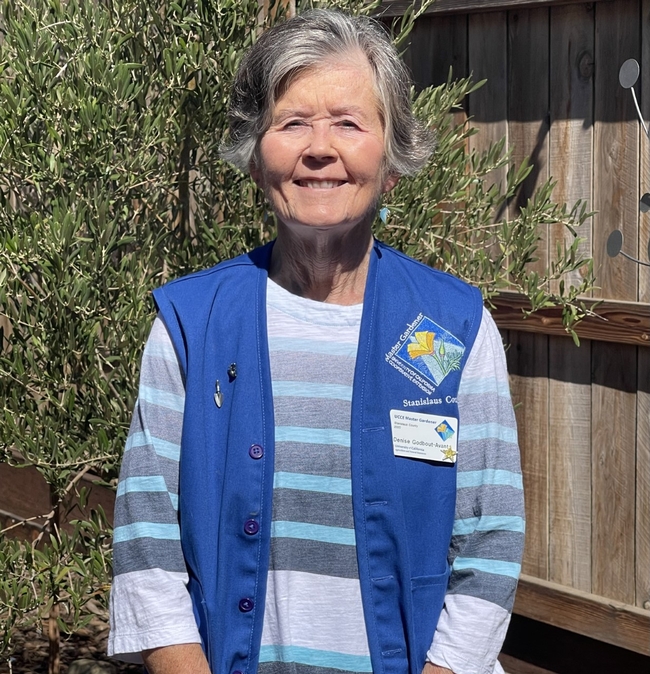
Denise Godbout-Avant has been a UC Cooperative Extension Master Garden in Stanislaus County since 2020.
- Author: Denise Godbout-Avant
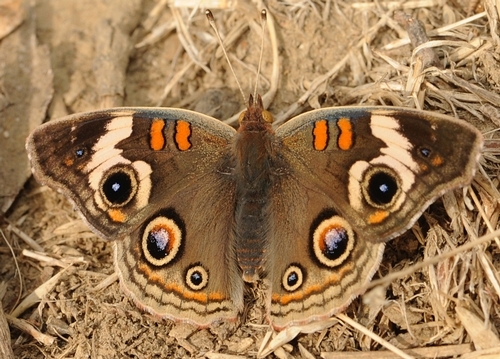
As the long, hot days of summer slide into cooler, shorter days of autumn, seasonal changes are occurring in my garden. Not as many plants are blooming, the leaves on deciduous trees and plants are becoming drier and starting to change color. Some plants are producing autumn berries that will sustain many birds as insects, another source of food, begin to disappear.
Quite a few butterflies have been showing up in my garden to take advantage of flowers that are still blooming. Butterflies I have been seeing include painted ladies (Vanessa cardui), common buckeyes (Junonia coenia), fiery skippers (Hylephila phyleus)and cabbage whites (Pieris rapae).
With the advent of winter, butterflies disappear since they cannot tolerate temperatures below 55°F or rainy weather. So, what happens to butterflies in the winter???
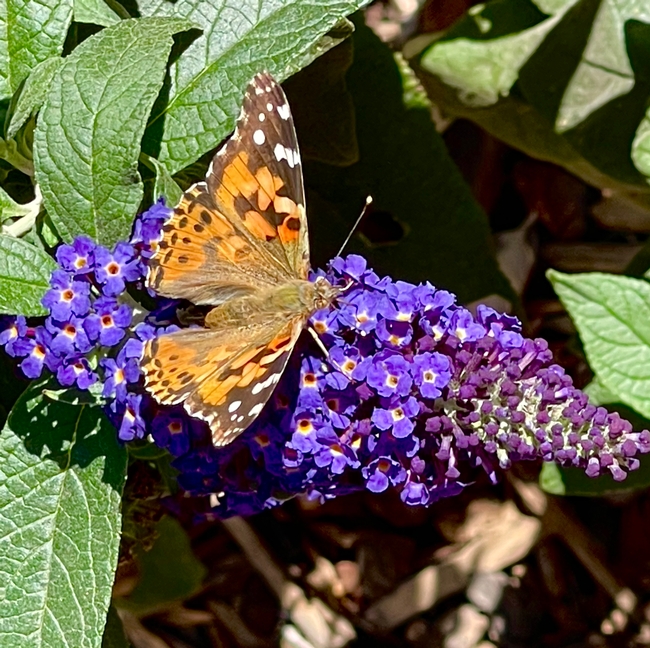
Some Butterflies Migrate
Some butterfly adults migrate south, overwintering in warmer climates.
Monarch butterflies are known for their astonishingly long spring and fall migrations. Both the eastern monarchs and western monarchs began their southern migrations in late August or early September from southern Canada/northern USA to their overwintering sites. The eastern variety generally heads to the oyamel fir forests in the mountains of central Mexico, whereas the western Pacific species have a shorter journey to California's coastline. You may see some western monarchs this fall resting or feeding on flowers in your garden as they fly through the Central Valley on their way their overwintering sites in coastal areas such as Santa Cruz, Pacific Grove, Pismo Beach, and San Diego.
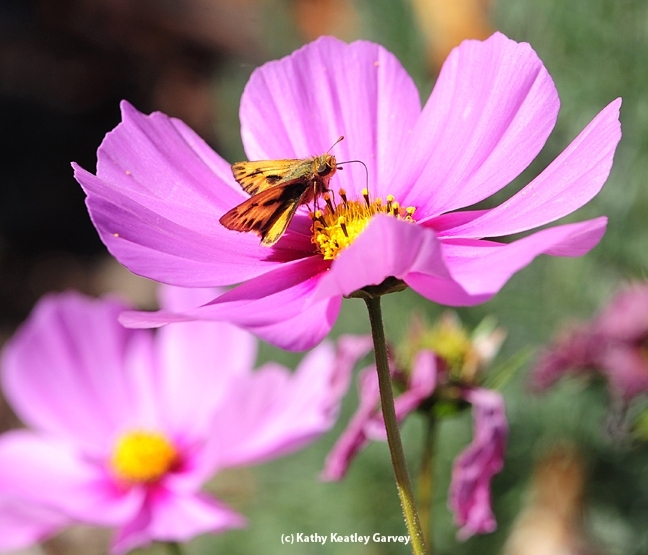
Other Winter Strategies
Most butterflies spend winter in the same area they spent summer.
Some lay their eggs in autumn on, or close to, their specific host plants with the eggs hatching the following spring. The common hairstreak (Satyrium californica) eggs are laid attached to twigs of oaks with the caterpillars feeding on newly emerged spring leaves.
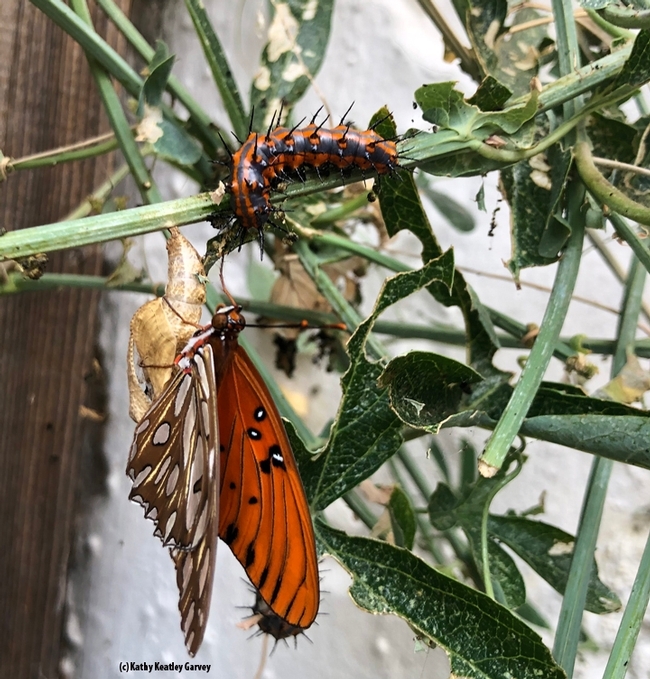
Some butterflies weather the cold as pupa within a chrysalis in a sheltered spot. During this time, the pupa will enter diapause (where development stops). An antifreeze chemical in their blood allows them to survive cold temperatures. Once the days lengthen, it will resume its transformation, emerging as an adult just as in time for blooming flowers that provide nectar. The tiger swallowtail's chrysalis (Papilio rutulus) will take refuge in deep shrubbery. The anise swallowtails (Papilio zelicaon) and cabbage whites also generally overwinter as a pupa in their chrysalis. Fiery skippers usually overwinter as pupae buried in leaves, but some adults will migrate to southern California.
Mourning cloaks (Nymphalis antiopa)go into dormancy as an adult. Their blood also contains an anti-freeze. They tuck themselves into cracks and crevices of rocks and trees.
Leaving the Leaves
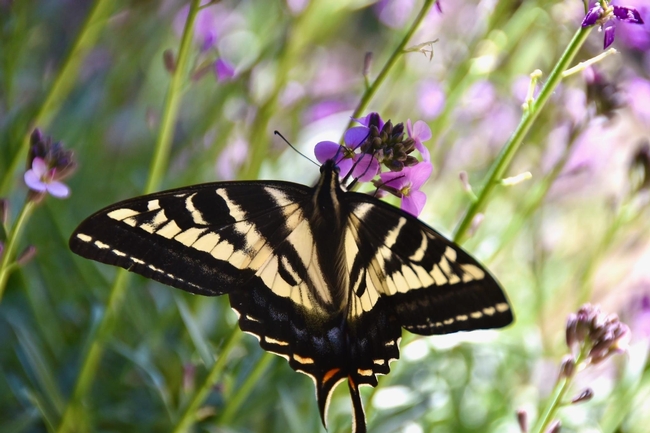
- Learn which butterflies live in your area and grow native plants for those specific species.
- Offer nectar plants in the fall and spring months for butterflies that are migrating, emerging from overwintering, or getting ready to go into winter dormancy/hibernation.
- Skip raking the leaves in your garden in autumn and leave standing plants alone until midspring, so overwintering butterfly larvae, pupae and adults have a place to hide. If leaving the leaves on your lawn is too messy for you, consider not disturbing the leaves in your planters.
- If you find what looks like a dead chrysalis (many resemble dead leaves) in your yard, garage, shed, do not disturb it. A butterfly may well emerge in the spring.
- Avoid using pesticides as much as possible.
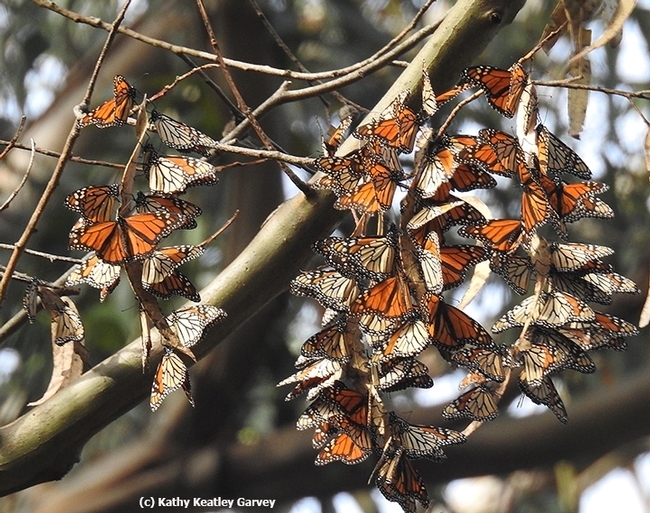
Resources
- Art Shapiro's Butterfly Site: https://butterfly.ucdavis.edu/butterflies
- Butterflies in Your Garden, Publication from UCCE Stanislaus County :https://ucanr.edu/sites/CEStanislausCo/files/345791.pdf
- Xerces Society - Pollinator Plants: Central Valley of California: https://xerces.org/publications/plant-lists/ppbi-california-central-valley
- California Native Plant Society: https://www.cnps.org/
- UC Davis Arboretum – Larval Hosts for Butterflies: https://arboretum.ucdavis.edu/blog/larval-host-plants-butterflies
Denise Godbout-Avant has been a UC Cooperative Extension Master Gardener in Stanislaus County since 2020.
Hello Sprout readers, We have a few questions for you…
- Are you tired of your landscape and ready for something new?
- Have you been thinking about replacing all or part of your lawn?
- Are you confused about how to transition from sprinkler to drip irrigation?
- Do you want to attract insect pollinators and birds to your landscape?
If you answered “yes” to any of these questions, this is the workshop for you! Learn how to replace your sprinkler system and convert to drip, hear about some low water use plants, including a list of plants that can provide bloom year-round.
Bring your questions! This is an especially great opportunity to speak with Tim Long, an expert in drip irrigation systems, as well as our other speakers who have experience with growing CA natives and lawn removal.
Workshop cost includes seeds, plants, and presentation materials and helps support our program. If you are unable to afford to pay for this class, not a problem! Just sign up so we know you are coming.
Where: Ag Center, Harvest Hall rooms D&E, 3800 Cornucopia Way, Modesto, 95358.
When: Saturday, October 7, 9:00 AM - 12:00 PM
Cost: $10
Questions? (209) 525-6800
Sign Up: https://ucanr.edu/new/front/yard
Instructors: UC Cooperative Extension, Stanislaus County Master Gardeners - Heidi Aufdermaur, Tim Long, Rhonda Allen, Doone Cockrell, and Bobbie Green.
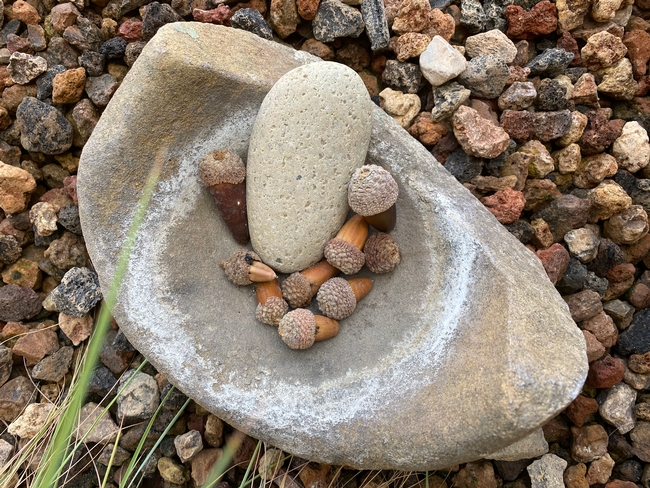
Valley Oak (Querus lobata):
The acorns were a staple food, which was leached (rinsed with water) to remove the bitterness, and ground into flour with mortar and pestles. The ground acorns were used in stews/soups, pancakes/tortillas, mush, or layered into pits and cooked with other plants and meats. Oak galls were squeezed to make a blue-black ink for tattoos and tannins were used to make dyes and decorate animal skins.
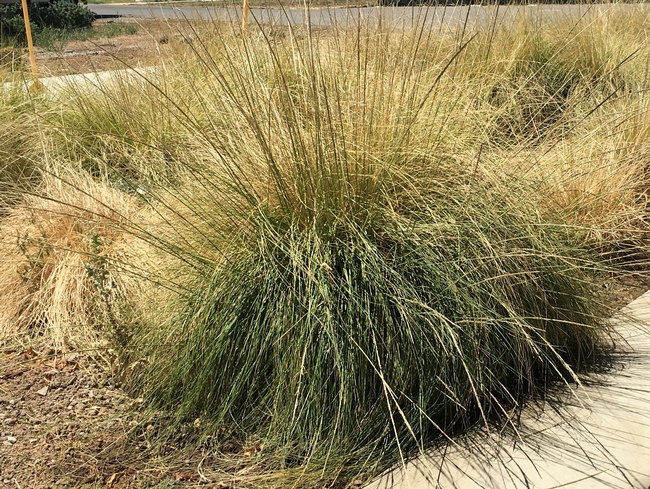
Deer Grass (Muhlenbergia rigens):
A major grass for creating beautiful, sometimes water-tight baskets to cook food, to carry and store food and other items. Stalks were generally harvested in the spring when easy to pick, then wrapped to keep straight and allowed to cure for a year. They were often soaked prior to weaving into basket. About 1600 stalks would be needed to make one basket.
One of the most beautiful California grasses, this easy-to-grow plant attracts butterflies in the spring with its cream-colored flowers and seed-eating birds in the summer.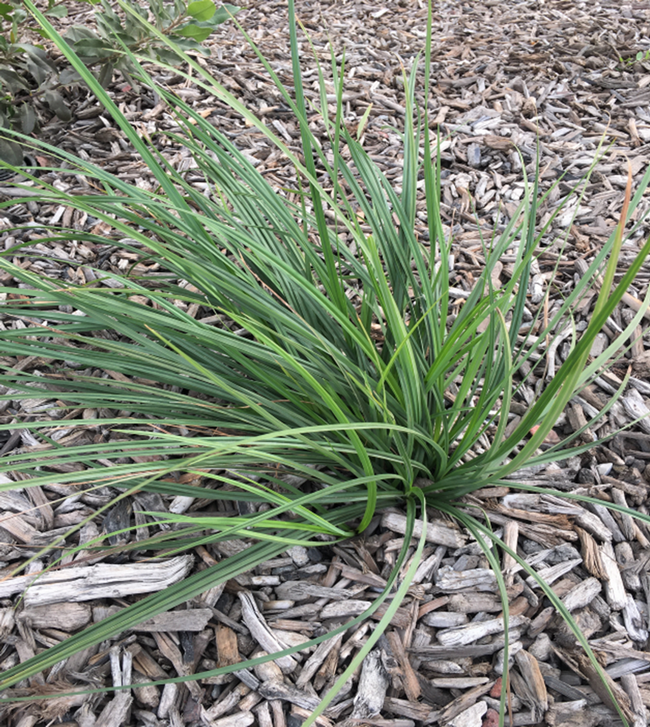
Santa Barbara Sedge (Carex barbarae):
The rhizomes (underground stems which generally grow horizontally) provided the strongest threads for basket making. The people would manage the rhizome growth by cleaning the soil of anything that might obstruct the growth (i.e., rocks) to allow the rhizomes to grow long and straight. An evergreen grass, the summer flowers range from cream, red and purple colors, which attract butterflies.
Toyon, aka California Holly (Heteromeles arbutifolia):
The wood from this sturdy shrub had many uses including tools, games/toys, fuel for smoking fish, and religious ceremonies. The red berries produced in the fall which were eaten after roasting over coals or dried in the sun.
An evergreen shrub, the summer white flowers attract bees and butterflies. Birds love the berries.
Blue Elderberry (Sambucus cerulea):
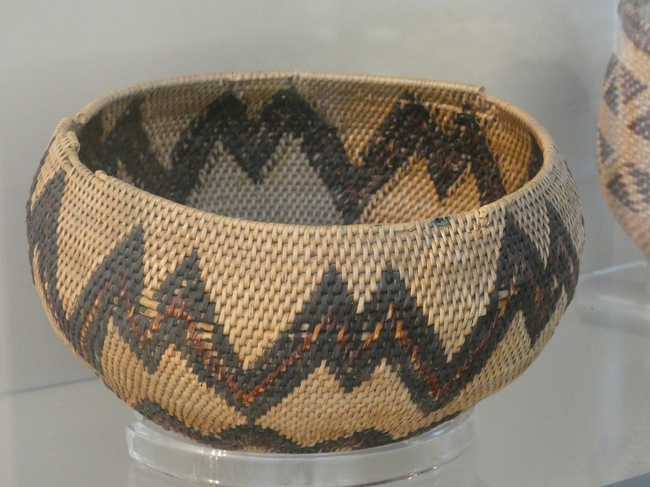
This tough, easy-to-grow shrub or tree is dormant in the winter. The spring and summer blooming cream or yellow flowers attract bees and butterflies, with their berries being an important food source to many birds.
Manzanita (Arctostaphylos manzanita):
Its distinctive red wood which was sometimes used to dry and smoke fish. The fruit was gathered in summer, then dried and ground to make coarse meal which would be mixed with a little water during winter months or made biscuits. They would make tea with the berries and tips of the branches, which apparently was a pleasant drink.
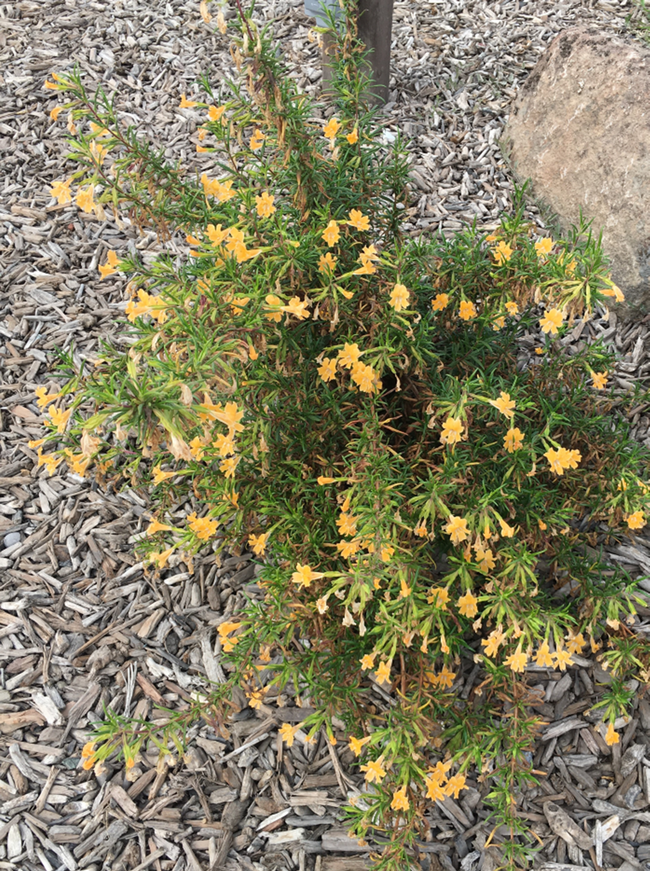
Sticky Monkey Flower (Mimulus aurantiacus):
The seeds were used as a food source. They were gathered, parched, ground, and added to foods or eaten by the handful. Flowers were used as décor after drying, made into wreaths, and used in religious ceremonies. The roots and leaves were used for medicinal purposes.
This drought-tolerant, evergreen shrub blooms in the spring, summer, and fall. The bright yellow tubular flowers attract hummingbirds, bees, and butterflies. Autumn seeds attract small birds.
Whenever I see any of these California native plants, I think of how the indigenous people of California used these plants over thousands of years. By growing them in our gardens, we honor that history, help the survival of these plants which provide food sources for so many birds, bees, and butterflies, reduce water usage, bring variety to our gardens, and joy to our spirits with their beauty.
Learn more at the Library - Take a free class!
This September, our UC Master Gardeners will present on the topic, "CA Native Plants" at 9 Stanislaus County Library locations. Visit our Calendar at https://ucanr.edu/sites/stancountymg/Calendar/ for dates, times, and locations.
Upcoming Workshop
On Saturday, October 7, 2023, we are offering our "The New Front Yard" workshop. Topics include drip irrigation, converting your yard to native plants, and how to garden for year-round bloom! Stay tuned for the registration announcement.
Resources:
- Enough For All: Foods of My Dry Creek Pomo and Bodega Miwuk People by Kathleen Rose Smith
- The Real California Cuisine: A Treatise on California Native-Plant Foods by Judith Larner Lowry
- Tending the Wild: Native American Knowledge and the Management of California's Natural Resources by M. Kat Anderson
- Indian Summer: A True Account of Traditional Life Among the Choinumni Indians of California's San Joaquin Valley
- Great Valley Museum of Natural History at Modesto Junior College's exhibit on Yokuts
- California Native Plant Society: https://www.calscape.org/
Acknowledgment: Lillian Vallee, English professor emeritus, Modesto Junior College, who has shared her passion and knowledge with me over the years of California native plants and their historical uses by the California native people.
Denise Godbout-Avant has been a UC Cooperative Extension Master Gardener in Stanislaus County since 2020.

